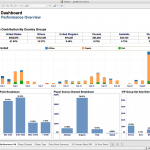Forecasting your Business’ Performance this New Year
Author and public speaker John Naisbitt, who specializes in the area of future studies once said that “The most reliable way to forecast the future is to try to understand the present.”
There is no doubt that our present will shape our future. 2016 was a major year globally in business, economics, social justice, politics and the continued conversation and research into how we preserve our environmental resources. Companies from healthcare to gaming experienced major shifts in how they must do business to attract, retain and manage customers. Political leaders had to answer tough questions and provide definitive plans for how their platforms will support the business economy. And consumers are more empowered with information then ever to make buying decisions based on values, sustainability and personal financial status. As we close out 2016, there are many things that business executives and leaders can learn from this eventful year using data analytics.
Let’s take a look at three difference scenarios and how Managers, Leaders, or Analysts can use predictive analytics to form a roadmap for doing, and succeeding in, business in the New Year.
Conservative Customer Acquisition Through All Quarters
Imagine we have traveled back to Q2 of 2016. Your company acquired some new customers in Q1 and they have stayed onboard. You then move into Q3 and you lost a couple of customers, but also acquired more to make up for the loss. How your company has done in terms of acquiring users/customers has been conservative but healthy. To forecast how acquisition will affect your company in 2017, you can look at what it cost to acquire these customers in 2016 and then explore ways to reduce these costs or increase the numbers of customers acquired. Elements that may increase customer acquisition in 2017 include diversifying marketing channels, improving growth of organic customers and exploring social media communications to engage potential customers.
Varying Customer Lifetimes Across Customer Base
Like any relationship, a customer’s relationship with a company can have varying lifecycles. Looking back at 2016 data, you can foresee 2017 by analyzing the lifetime of your customer. Did most of your customers stay onboard throughout the year? Or did many only stay onboard for 60 or even 30 days? Your customer base is more than how many make up the cohort and what they invest in your company financially. One of the most overlooked pieces of data is the fact that customer lifetimes are vital to predicting target goals for customer lifetimes in the New Year.
Monthly Purchasing Behavior Among Customers
Month to month things change and this is also the case for consumers and users of your business. Think about your own consumer behavior. One month, you may engage in big-ticket item purchases and the next you may completely abstain from spending outside of necessities. Analyzing data for your monthly cohort of user/customers in 2016 such as how often do they buy, how recent their last purchase was, and the overall amount spent per user will help shed light on ways to segment the user base into tiers that are more manageable. This way, your plan for next year is to see how to move your customer up from a low tier to a higher tier and equally present marketing offers to increase monthly spending.
Getting into the practice of taking time at the end of one year/beginning of the next to engage in predictive analysis is good for reflecting on your wins and losses for the year and forecasting for the one ahead. Utilizing data within these three areas of consumer acquisition, retention and monetization provides a solid roadmap of the year ending. As business picks up in 2017, look back to this data often as a basis of comparison to see where you stand from the same period in time in 2016.
Wishing you all a prosperous New Year!
Visit our homepage, subscribe to more articles and updates








